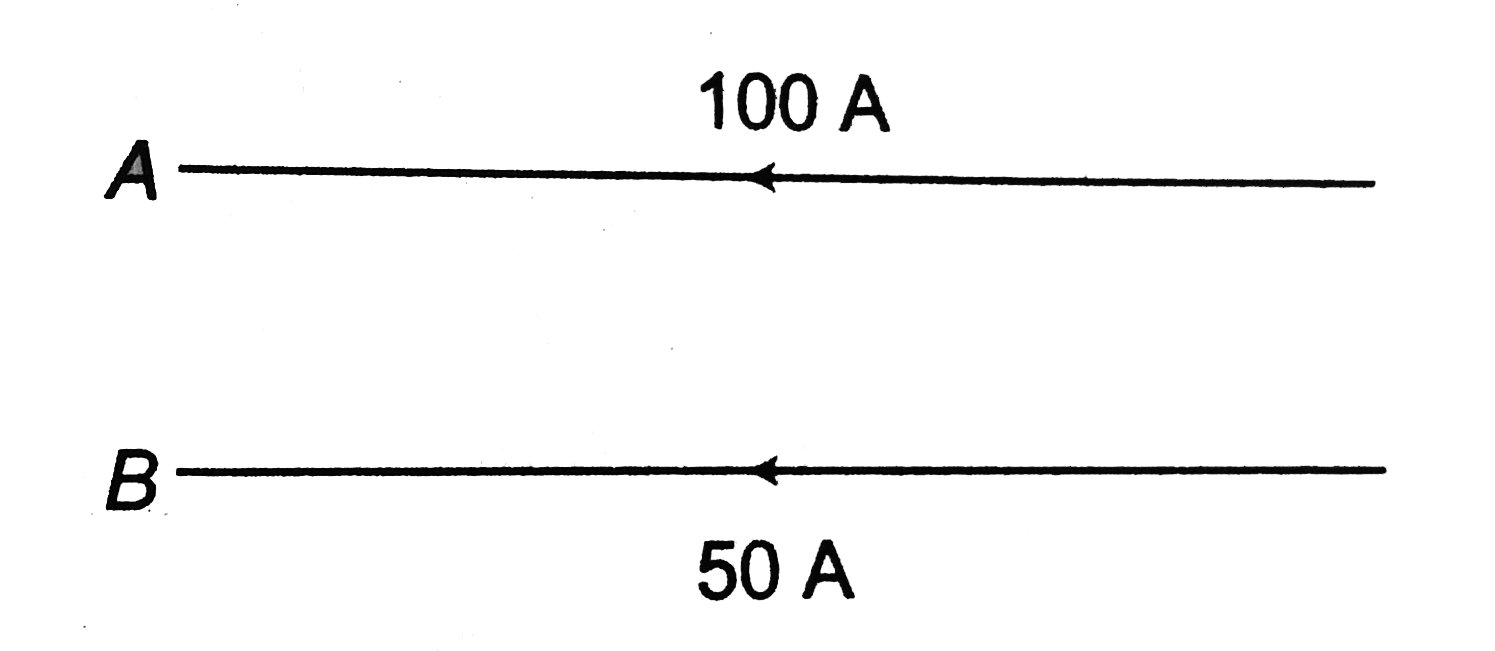Two long parallel conductors carry 100 A current. If the conductors are separated by 20 mm, the force per metre of length of each conductor will be
100 N
10 N
1 N
0.1 N
To solve the problem of finding the force per meter of length between two long parallel conductors carrying a current of 100 A and separated by a distance of 20 mm, we can follow these steps:
1. Identify the Given Values:
- Current (I) in each conductor = 100 A
- Distance (d) between the conductors = 20 mm = 20 × 10^(-3) m
2. Use the Formula for the Force per Unit Length:
The force per unit length (F/L) between two parallel conductors carrying currents I1 and I2 separated by a distance d is given by the formula:
F/L=μ02π⋅I1I2d
where μ0 (the permeability of free space) is approximately 4π×10−7T m/A.
3. Substituting the Values:
Since both conductors carry the same current (I1 = I2 = I = 100 A), we can simplify the formula:
F/L=μ02π⋅I2d
Substituting the values:
F/L=4π×10−72π⋅(100)220×10−3
4. Simplifying the Expression:
F/L=2×10−720×10−3⋅10000
F/L=2×10−7×1000020×10−3
F/L=2×10−320×10−3
F/L=220=110=0.1N/m
5. Final Result:
The force per meter of length of each conductor is:
F/L=0.1N
Conclusion:
Thus, the force per meter of length of each conductor is 0.1 N.
- Current (I) in each conductor = 100 A
- Distance (d) between the conductors = 20 mm = 20 × 10^(-3) m
The force per unit length (F/L) between two parallel conductors carrying currents I1 and I2 separated by a distance d is given by the formula:
F/L=μ02π⋅I1I2d
where μ0 (the permeability of free space) is approximately 4π×10−7T m/A.
Since both conductors carry the same current (I1 = I2 = I = 100 A), we can simplify the formula:
F/L=μ02π⋅I2d
Substituting the values:
F/L=4π×10−72π⋅(100)220×10−3
F/L=2×10−720×10−3⋅10000
F/L=2×10−7×1000020×10−3
F/L=2×10−320×10−3
F/L=220=110=0.1N/m
The force per meter of length of each conductor is:
F/L=0.1N
Thus, the force per meter of length of each conductor is 0.1 N.
Topper's Solved these Questions
Similar Questions
Define SI unit of current in terms of the force between two parallel current carrying conductors.
(b) Two long straight parallel conductors carrying steady currents IaandIb along the same direction are separated by a distance d. How does one explain the force of attraction between them ? If a third conductor carrying a current Ic in the opposite direction is placed just in the middle of these conductors , find the resultant force acting on the third conductor.
View SolutionTwo long straight parallel conductors carrying currents I1andI2 along the same direction are separated by a distance 'd'. How does one explain the force of attraction between them?
If a third conductors carrying a current I3 in the opposite direction is placed just in the middle of these conductors , find the resultant force acting on the third conductor.
View Solution
Knowledge Check
A current carrying conductor produces ______
Aonly heatBonly magnetic fieldCBoth heat and magnetic fieldDNone of the aboveTwo long straight parallel conductors are separated by a distance of 5 cm and carrying current 20 A. what work per unit length of a conductor must be done to increases the separation between conductors to 10 cm, if the current flows in the same direction ?
A8×10−5loge2Bloge2C10−7loge2Dnone of theseThe two linear parallel conductors carrying currents in the opposite direction…………………each other.
AIf both assertion and reason are true and reason is the correct explanation of assertion.BIf both assertion and reason are true but reason is the correct explanation of assertion.CIf assertion is true but reason is falseDIf both assertion and reason are false.

If two conductors carry current in opposite direction, then:
View SolutionIn given figure X and Y are two long straight parallel conductors each carrying a current of 2A The force on each conductor is F newtons When the current in each is changed to 1A and reversed in direction the force on each is now
 .
.
View SolutionTwo long thein, parallel conductors carrying equal current in the same direction are fixed parallel to the x-axis one passing throught magnetic field due to the two conductors at any point is B Which of the following are correct ?

View SolutionThe force between two long parallel wires A and B carrying current is 0.004Nm−1. The conductors are 0.01 m apart. If the current in conductor A is twice that of conductor B, then the current in the conductor B would be
View SolutionTwo long parallel conductors are carrying currents in the same direction as shown in the figure. The upper conductor A carrying a current of 100A is held firmly in position. The lower conductor B carries a current of 50A and free to move up and down. The linear mass density of the lower conductor is 0.01 kg/m.

View Solution
